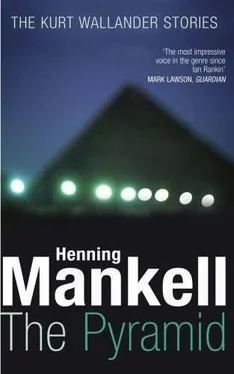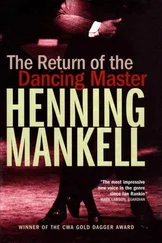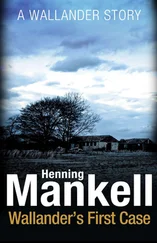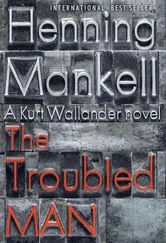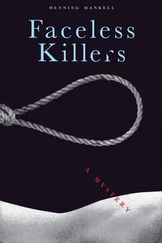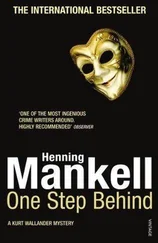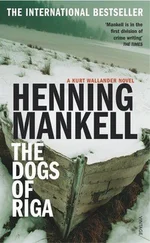'It is dark and sombre and tragic,' he began. 'But Simon Lamberg and Louise Wislander continued to meet in secret after that bus trip. And Louise's husband knew nothing of it. Until recently, shortly before she died. She had a tumour on her liver. On her deathbed she confessed her infidelity. Wislander had then been overcome by something that can only be described as insanity. In part, grief over his wife's death, in part rage and anguish over her betrayal. He started stalking Lamberg. In his mind, Lamberg was also guilty of his wife's death. He took sick leave and spent almost all his time here in Ystad. He kept the studio under surveillance, staying at one of the small hotels in town. He followed the cleaning lady, Hilda Waldén. One Saturday, he broke into her apartment, took the keys, and had them copied. Before she returned, he replaced the originals. Then he entered the studio and killed Lamberg with the candelabrum. After that, in his confusion, he still believed that Lamberg was alive. He actually returned in order to kill him a second time. He dropped the hymn book when he was hiding in the garden. The fact that he turned on the radio and changed the setting is a bizarre detail. He had apparently started imagining that he would be able to hear God's voice through the radio. That God would forgive him for the sin he had committed. But all he managed to find was a station that broadcast rock music. The photographs were Lamberg's work through and through. They had nothing to do with the death. He nourished a contempt for politicians and other powerful men. In addition, he was displeased with the work of the police. He was a curmudgeon. A little man who tried to control his world by deforming faces. But this solves our case. I can't help pitying Wislander. His world collapsed. He didn't have the strength to bear it.'
The room was silent.
'Why did Louise visit Lamberg's handicapped daughter?' Hansson asked.
'I've been asking myself that,' Wallander answered. 'Perhaps her love affair had religious undertones. Perhaps the two of them were involved in praying for Matilda? Did Louise then go to the nursing home in order to check the effect of her prayers? Perhaps she regarded Matilda as the victim of her parents' earlier sinful life? We'll never know. As little as we'll ever know what bound these two singular people together. There are always secret rooms that we don't manage to find a way into. And perhaps that's for the best.'
'One can take a step further,' Rydberg said, 'if you think about Wislander. Perhaps his rage actually stemmed from the fact that Lamberg had seduced his wife from a religious perspective. Not erotically. One has reason to question if it was only the usual jealousy that played a role in this case.'
Again, there was silence. Then they went on to discuss Lamberg's pictures.
'He must have been crazy in his own way,' Hansson said. 'To spend his spare time distorting images of well-known people.'
'Perhaps the explanation is quite different,' Rydberg suggested. 'Perhaps there are people in today's society that feel so powerless they no longer partake in what we call democratic society. Instead they devote themselves to rites. If this is the case, our nation is in trouble.'
'I hadn't considered that possibility,' Wallander said. 'But you could be right. And in that case I agree with you. Then the foundation has really started to crack.'
The meeting came to an end. Wallander felt tired and despondent, despite the beautiful weather. And he missed Mona.
Then he checked the time. A quarter past four.
He had to go back to the dentist.
How many times it had been, he no longer knew.
The aeroplane flew in over Sweden at a low altitude just west of Mossby Beach. The fog was thick out at sea but growing lighter closer to shore. Contours of the shoreline and the first few houses rushed towards the pilot. But he had already made this trip many times. He was flying by instruments alone. As soon as he crossed the Swedish border and identified Mossby Beach and the lights along the road to Trelleborg, he made a sharp turn north-east and then another turn east. The plane, a Piper Cherokee, was obedient. He positioned himself along a route that had been carefully planned. An air corridor cut an invisible path over an area in Skåne where the houses were few and far between. It was a little before five o'clock on the morning of 11 December 1989. Around him there was an almost solid darkness. Every time he flew at night he thought about his first few years, when he had worked as a co-pilot for a Greek company that had transported tobacco at night and in secret from what had then been Southern Rhodesia, restricted by political sanctions. That had been in 1966 and 1967. More than twenty years ago. But the memory never left him. That was when he had learned that a skilled pilot can fly even at night, with a minimum of aids, and in complete radio silence.
The plane was now flying so low that the pilot did not dare to take it any lower. He began to wonder if he would have to turn back without completing his mission. That happened sometimes. Safety always came first and visibility was still bad. But suddenly, right before the pilot would have been forced to make his decision, the fog lifted. He checked the time. In two minutes he would see the lights where he was supposed to make his drop. He turned round and shouted out to the man who was sitting on the only chair left in the cabin.
'Two minutes!'
The man behind him in the darkness directed a torch into his own face and nodded.
The pilot peered out into the darkness. One minute to go now, he thought. And that was when he saw the spotlights that formed a square of two hundred metres per side. He shouted to the man to make himself ready. Then he prepared for a left turn and approached the lighted square from the west. He felt the cold wind and light shaking of the fuselage as the man behind him opened the cabin door. Then he put his hand on the switch that glowed red in the back of the cabin. He had decreased his speed as much as possible. Then he threw the switch, the light changed to green, and he knew that the man back there was pushing out the rubber-clad cistern. The cold wind stopped when the door shut. At that point, the pilot had already changed his course to the south-east. He smiled to himself. The cistern had landed now, somewhere between the spotlights. Someone was there to collect it. The lights would be turned off and loaded onto a truck, and then the darkness would become as compact and impenetrable as before. A perfect operation, he thought. The nineteenth in a row.
He checked his watch. In nine minutes they would pass over the coast and leave Sweden again. After another ten minutes he would rise another several hundred metres. He had a Thermos with coffee next to his seat. He would drink it as they crossed the sea. At eight o'clock he would set his plane down on his private landing strip outside Kiel, and then get into his car and already be on his way to Hamburg, where he lived.
The aeroplane lurched once. And then again. The pilot checked his instrument panel. Everything seemed normal. The headwind was not particularly strong, nor was there any turbulence. Then the plane lurched a third time, more strongly. The pilot worked the rudder, but the plane rolled onto its left side. He tried to correct it without success. The instruments were still normal. But his extensive experience told him that something wasn't right. He could not straighten the plane up. Although he was increasing his speed, the plane was losing altitude. He tried to think with complete calm. What could have happened? He always examined a plane before he took off. When he had arrived at the hangar at one o'clock in the morning, he had spent over half an hour examining it, going through all the lists that the mechanic provided, and then he had followed all the directions on the checklist before take-off.
Читать дальше
